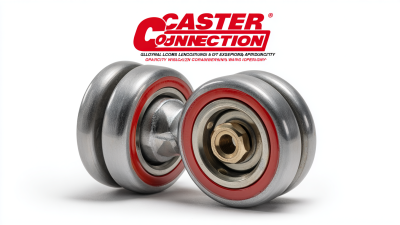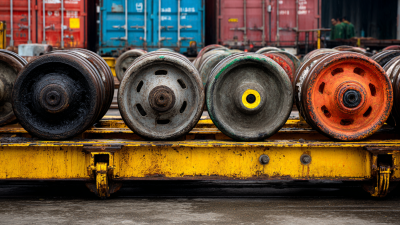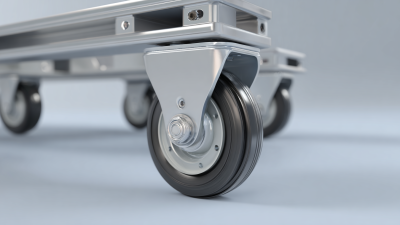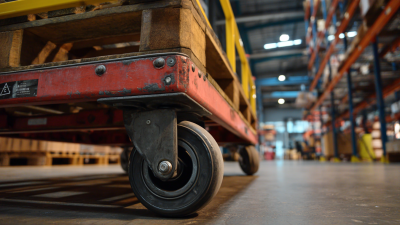
How to Choose the Right Caster Trolley Wheels for Your Needs
 Choosing the right caster trolley wheels is crucial for optimizing efficiency and safety in various industrial and commercial applications. According to a recent market analysis by ResearchAndMarkets, the global caster wheels market is projected to grow significantly, reaching an estimated value of over $2 billion by 2026, owing to increasing automation in warehouses and the demand for mobility solutions in healthcare and retail sectors.
Choosing the right caster trolley wheels is crucial for optimizing efficiency and safety in various industrial and commercial applications. According to a recent market analysis by ResearchAndMarkets, the global caster wheels market is projected to grow significantly, reaching an estimated value of over $2 billion by 2026, owing to increasing automation in warehouses and the demand for mobility solutions in healthcare and retail sectors.
Selecting the appropriate caster trolley wheels can greatly enhance load-bearing capacity, maneuverability, and durability, which are vital for operations involving heavy equipment or frequent movement. By understanding the specific needs based on material, size, and wheel type, businesses can ensure they invest in the right solutions to meet their operational demands while minimizing downtime and maintenance costs.
This guide will provide key insights into how to choose the ideal caster trolley wheels tailored to your requirements.
Understanding Different Types of Caster Trolley Wheels: Material and Design Choices
When selecting the right caster trolley wheels, it’s essential to understand the various materials and designs available. Casters can be made from rubber, plastic, nylon, and metal, each influencing performance and functionality. Rubber wheels are ideal for quiet and smooth movement on uneven surfaces, while nylon wheels are durable and resistant to wear, making them great for heavy loads. If you're transporting items on delicate floors, soft polyurethane wheels can prevent damage while offering easy maneuverability.
**Tips:** Always consider the load capacity of the wheels; exceeding this limit can lead to wheel failure and accidents. Additionally, assess the environmental conditions where the trolley will be used. For indoor use, softer materials might be preferred, while tougher, corrosion-resistant materials like stainless steel are more suitable for outdoor environments.
Beyond materials, design plays a crucial role in usability. Swivel casters provide excellent maneuverability, especially in tight spaces, while fixed casters offer stability for straight movement. If you require a mix of both, consider a combination of swivel and fixed casters. Prioritize the swivel radius and height of the wheel to ensure compatibility with your trolley’s dimensions.
**Tips:** Always test the wheels before finalizing your choice, ensuring they meet your maneuverability and stability expectations.

Evaluating Load Capacity: How Much Weight Can Your Caster Handle?
When selecting the right caster trolley wheels, evaluating the load capacity is a critical factor to consider. The load capacity refers to the maximum weight that the wheels can safely support during operation. Choosing wheels that can handle the required load ensures not only efficient performance but also safety in transporting goods. It's important to take into account the weight of the objects you plan to move, as well as any other factors that might influence the load, such as terrain and movement frequency.
In industrial settings, the cumulative impact of loads and the conditions in which the wheels will operate can affect their longevity and performance. For example, if the environment involves rough surfaces or uneven pavements, opting for wheels designed to absorb shocks and reduce wear would be advantageous. Additionally, various materials and designs are available to match specific load requirements—whether for lightweight tasks or heavy-duty applications. Therefore, careful evaluation of the load capacity, alongside other environmental considerations, will help ensure that the selected caster trolley wheels meet your needs effectively.
Importance of Wheel Diameter: Finding the Right Size for Your Caster Trolley
When selecting caster trolley wheels, one of the most crucial factors to consider is wheel diameter. The diameter of the wheel significantly influences the trolley's overall performance, mobility, and suitability for specific surfaces. Larger wheels typically roll more easily over obstacles and uneven terrain, making them ideal for outdoor use or environments with debris. On the other hand, smaller wheels offer better maneuverability in tight spaces, which is vital for indoor applications or when navigating around furniture.
Additionally, the right wheel diameter can enhance the load capacity of the caster trolley. A larger wheel can distribute weight more effectively, reducing stress on the axle and extending the life of the trolley. Conversely, smaller wheels may struggle under heavy loads, leading to increased friction and potential wear. Ultimately, choosing the appropriate diameter ensures that the trolley operates efficiently and meets the demands of your unique application, whether it involves transporting materials in a warehouse or moving equipment around a workshop.
Choosing the Right Caster Trolley Wheels: Wheel Diameter Comparison
Assessing Wheel Surface Options: Tread Types for Different Flooring Conditions
When selecting caster trolley wheels, understanding the various tread types suitable for different flooring conditions is crucial. According to a report by the Caster and Wheel Manufacturers Association (CWMA), the right wheel surface can enhance mobility, protect flooring, and improve overall efficiency in industrial settings. For example, soft rubber wheels offer superior grip on smooth surfaces, minimizing the risk of slippage and protecting delicate floors from scratches. These wheels typically perform well in environments such as warehouses with polished concrete or retail spaces with tile flooring.

Conversely, for rough or uneven terrain, hard plastic wheels are often recommended due to their durability and ability to withstand more abrasive conditions. A study by the North American Material Handling Association highlighted that hard floor wheels can reduce rolling resistance by up to 20%, making them ideal for environments like manufacturing plants with cement floors or gravel paths. By assessing the tread type in relation to the specific flooring condition, users can significantly enhance the performance and lifespan of their caster trolleys, maximizing both safety and efficiency in their operations.
Selecting the Right Wheel Bearing: Impact on Mobility and Performance
When selecting caster trolley wheels, one of the most critical aspects to consider is the type of wheel bearing used. Wheel bearings play a vital role in determining the ease of mobility and overall performance of the trolley. There are several types of bearings available, including ball bearings, roller bearings, and sleeve bearings, each offering distinct advantages depending on the intended application. For instance, ball bearings generally provide smoother movement and are ideal for applications where speed is essential, while roller bearings can handle heavier loads with reduced friction.
Additionally, the choice of bearing material can significantly impact the longevity and durability of the wheels. Options such as steel bearings are known for their strength and resistance to wear, making them suitable for heavy-duty environments. On the other hand, plastic or nylon bearings are lightweight and corrosion-resistant, making them ideal for applications where environmental factors can affect performance. Understanding the specific requirements of your trolley’s application, along with the implications of different wheel bearings, will help ensure optimal mobility and efficiency tailored to your needs.
How to Choose the Right Caster Trolley Wheels for Your Needs - Selecting the Right Wheel Bearing: Impact on Mobility and Performance
| Wheel Diameter (inches) | Load Capacity (lbs) | Material Type | Wheel Bearing Type | Ideal Surface |
|---|---|---|---|---|
| 4 | 250 | Rubber | Ball Bearing | Concrete |
| 5 | 300 | Nylon | Roller Bearing | Tile |
| 6 | 400 | Polyurethane | Plain Bearing | Asphalt |
| 8 | 600 | Steel | Spherical Bearing | Gravel |
| 10 | 800 | Rubber | Ball Bearing | Uneven |
Related Posts
-

What Are the Key Features of Caster Trolley Wheels
-

Understanding the Challenges of Heavy Caster Wheels in Industrial Applications
-

Global Leader in Caster Connection Wheels Manufacturing for Export Quality and Innovation
-

Navigating Export Certification for Best Heavy Caster Wheels: A Guide for Global Buyers
-

What is a Caster Swivel Wheel and How It Enhances Mobility in Industrial Applications
-

Maximizing Efficiency with the Best Caster Trolley in Your Operations
